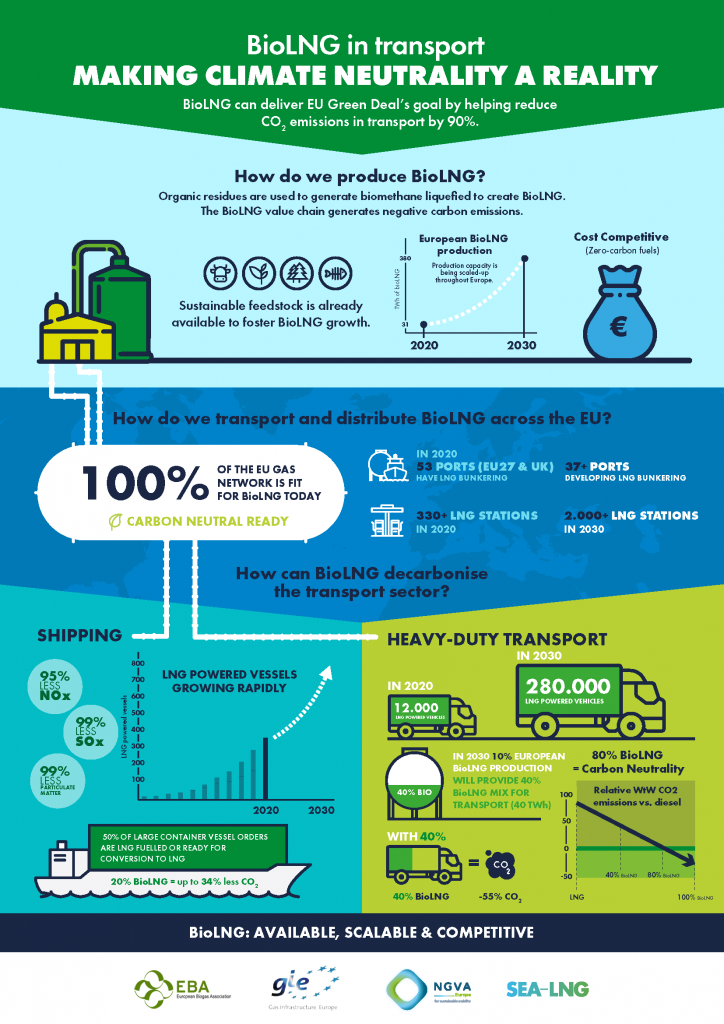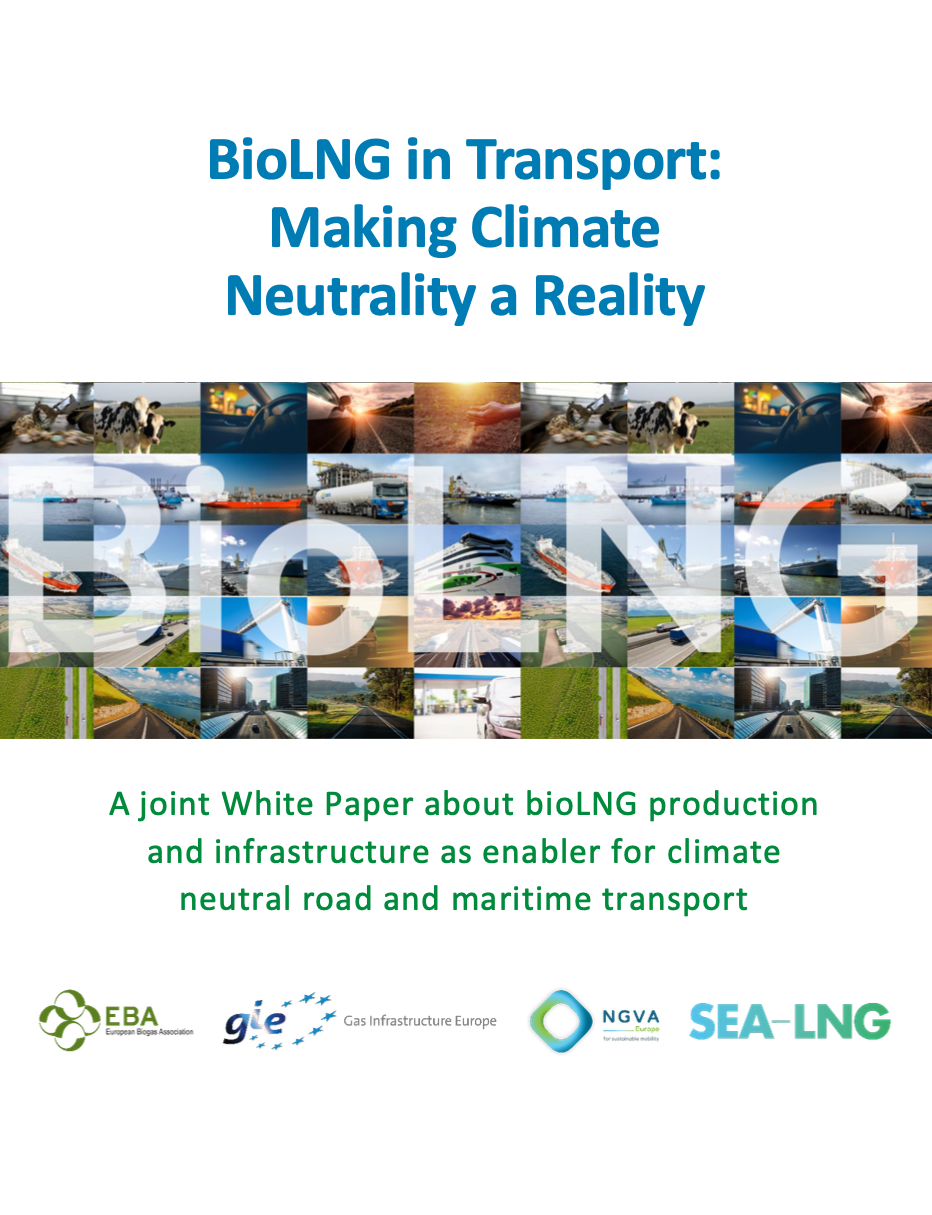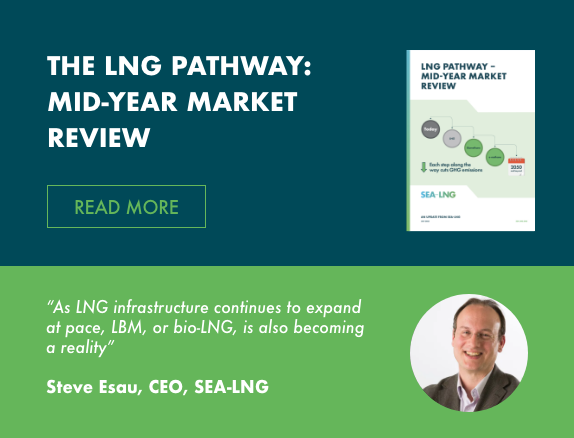Reports < Back
New joint paper: ‘BioLNG makes carbon neutrality a reality for EU transport’
23rd November 2020

Brussels, 23 November 2020 – today, the European Biogas Association (EBA), Gas Infrastructure Europe (GIE), the Natural & bio Gas Vehicle Association (NGVA Europe) and SEA-LNG published a joint paper, which demonstrates the concrete benefits of using BioLNG to decarbonise hard to abate transport sectors through the provision of the latest facts and figures.
Ahead of the upcoming Smart Sustainable Mobility Strategy which will be published by the European Commission in December, the paper calls upon the European Institutions to recognise the potential for BioLNG to meet greenhouse gas (GHG) targets, and continue to acknowledge the benefits available today of LNG and BioLNG in maritime and road transport to reduce GHG as well as local pollution emissions harmful to the heath of EU citizens.
The joint paper highlights the true potential for BioLNG to decarbonise heavy-duty transport and shipping in a fast and cost-effective way. It illustrates how BioLNG can help the EU reach its 2030 climate targets and become climate neutral by 2050. Since the BioLNG production process captures carbon, the BioLNG value chain generates negative carbon emissions. Hence, by running EU trucks on 100% BioLNG, it is possible to remove CO2 emissions from the atmosphere.
The EU production of BioLNG is set to increase tenfold by 2030. EU LNG heavy-duty transport is expected to reach 280.000 units in the same period. Using a 40% BioLNG mix with LNG will help reduce the CO2 emissions from those trucks by 55%. This can be achieved using only 10% (40TWh) of Europe’s total BioLNG production (380TWh). In the shipping sector, 50% of large container vessel orders today are LNG fuelled or ready for conversion to LNG. 20% of BioLNG mix in maritime transport would reduce CO2 emissions by up to 34%. In mid-November, SEA-LNG member Total completed the world’s largest LNG bunkering operation to date in Rotterdam supplying 17,300 cubic metres of LNG to a French 23,000 TEU Ultra-Large Container Vessel, 13% of which was BioLNG.
BioLNG can be transported using the existing LNG infrastructure with no further technological adaptations or additional costs. For this reason, the support of LNG infrastructure is fundamental to ensure the deployment of Bio-LNG in the coming years. Today, the EU has 53 ports where LNG bunkering is available and over 330 filling LNG stations. This number will increase exponentially in the coming years. In the case of LNG stations, it will be six times bigger, reaching 2.000 LNG stations by 2030. The use of the current infrastructure also boosts cross-border trade of BioLNG in Europe.
Harmen Dekker, Director of the European Biogas Association stressed: “BioLNG is available today and scalable for tomorrow. It is a sustainable and cost competitive carbon neutral fuel if we take into account all positive externalities of the Bio-LNG value chain. To ensure maximum production potential and maximum benefit for EU consumers, the new revision of the EU Renewable Energy Directive should integrate more feedstocks such as residues which cannot be used for other purposes and secondary crops. The EU must also create a single market for biomethane and BioLNG by facilitating trading of volumes and certificates across EU borders free of technological or political barriers.”
Roxana Caliminte, Deputy Secretary General, Gas Infrastructure Europe added: “The infrastructure we use today for LNG can be used tomorrow for BioLNG with little or no modifications. There are no stranded assets – only scale up effects for climate-neutral BioLNG. If we want to be successful in cleaning up transport, it will be crucial that the EU recognizes the vital role of LNG infrastructure in the Smart and Sustainable Mobility Strategy.”
Andrea Gerini, Secretary General of NGVA Europe emphasised: “By integrating the fuel dimension and recognizing the benefits of gas in transport into files like the Smart Mobility Strategy and the Revision of the CO₂ Emission Performance Standards Regulation, the EU will enable and stimulate the decarbonisation effect of BioLNG. This is thanks to its already existing and rapidly growing vehicle fleet, and available fuelling infrastructure.”
Steve Esau, General Manager, SEA-LNG commented: “BioLNG provides a proven and commercially viable way of incrementally decarbonising the European shipping industry using existing vessels and existing LNG infrastructure. We continue to advocate for regulators to adopt a goal-based approach founded on technology openness, and guarantee a true level playing field between different mobility solutions. Whether this is on a well-to-wheel or well-to-wake basis.”
BioLNG makes carbon neutrality a reality for EU transport

